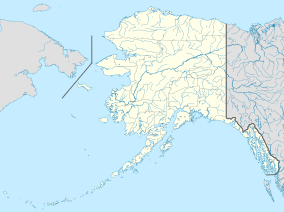Afognak Island State Park facts for kids
Quick facts for kids Afognak Island State Park |
|
|---|---|
|
IUCN Category III (Natural Monument)
|
|
| Location | Kodiak Island Borough, Alaska, United States |
| Area | 75,047 acres (303.70 km2) |
| Elevation | 161 ft (49 m) |
| Established | 1892 & 1994 |
| Named for | Afognak Island |
| Governing body | Alaska Department of Natural Resources |
| Website | Afognak Island State Park |
Afognak Island State Park is a huge state park in Alaska, covering about 75,047-acre (30,370 ha) of land. It's located on Afognak Island, which is part of the Kodiak Island Borough in the United States. This island is found northeast of Kodiak Island, near the Alaska Peninsula.
Most of Afognak Island State Park is wild and untouched. It's famous for its rough, hilly land (called rugged topography) and the many different kinds of wildlife that live there. You can visit Afognak Island State Park all year round for fun activities like fishing, hunting, and hiking. To get there, you usually take a float plane from Kodiak to different spots around the park. The park covers the northern and eastern parts of Afognak Island, surrounding areas like Perenosa, Seal, and Tonki Bays. It also shares a border with part of the Kodiak National Wildlife Refuge to the west.
Contents
History of Afognak Island State Park
How the Park Was Formed
Afognak Island State Park has a long history. It was first set aside as a special protected area in the United States way back in 1892. This was 67 years before Alaska even became a state! Back then, it was called the Afognak Island Forest and Fish Culture Reserve. Its main goal was to protect wildlife and the places where salmon lay their eggs.
Later, in 1908, the area became part of the Chugach National Forest. Then, in 1980, the land was given to native corporations as part of the Alaska Native Claims Settlement Act.
Protecting the Land After the Oil Spill
Afognak Island State Park officially became a state park in 1994. This happened when about 41,549 acres (168.14 km2) of land were sold to the state. The goal was to help restore and protect the natural habitat after the terrible Exxon Valdez oil spill. In 2001, another 33,498 acres (135.56 km2) were added to the park. This extra land was also bought with money from the Valdez oil spill case to protect even more important habitats.
Wildlife and Nature in the Park
Afognak Island State Park is mostly in its natural, untouched state. Only a small part of the park near Seal Bay was logged in the 1990s. The park is home to very old Sitka spruce trees, forming an old-growth forest. These forests are very important for the environment.
The park also has many places where different kinds of salmon come to lay their eggs. You can see many animals here, including Sitka deer, large Kodiak bears, Roosevelt elk, and unique birds like the marbled murrelet.
Fun Things to Do in the Park
Afognak Island State Park offers a true wilderness experience. There are two cabins you can rent if you want to stay overnight: Pillar Lake Cabin and Laura Lake Cabin. Both are located near their namesakes, Pillar Lake and Laura Lake. These lakes are in remote areas, meaning they are far from towns and roads.
Pillar Lake Cabin
Pillar Lake Cabin is about a 20-minute floatplane flight from Kodiak. Once Pillar Lake freezes over in winter, the cabin cannot be reached until the ice melts. There are no developed hiking trails around Pillar Lake. However, a beach on the ocean is just a short walk away. You can find Dolly Varden trout in the lake, but there are no salmon streams nearby.
Laura Lake Cabin
Laura Lake Cabin is a bit further, about a 35-minute flight from Kodiak. It's located on the northern side of the island, close to Pauls Bay. Like Pillar Lake, Laura Lake also freezes in winter, making the cabin inaccessible until spring. Laura Lake is a long lake, about three miles (5 km) long. It's a very important area for salmon to lay their eggs. Because so many salmon are in the lake, bears are often in the area. Visitors need to be very careful and follow safety rules around bears.


